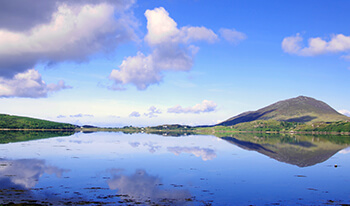The Skellig Islands (Irish: Na Scealaga) are two small, steep and rocky islands lying about 16 km west of Bolus Head on the Iveragh Peninsula in County Kerry, Ireland. They are famous for their thriving gannet and puffin populations, and for an early Christian monastery that is a UNESCO World Heritage Site. The smaller island is Little Skellig (Sceilig Bheag in Irish). It is closed to the public, and holds Ireland's largest and the world's second-largest Northern Gannet colony, with almost 30,000 pairs. It is about 1.5 km east of Great Skellig.
Also known as Skellig Michael (Sceilig Mhichíl in Irish), Great Sceilig is the larger of the two islands, rising to over 230 m above sea level. With a sixth-century Christian monastery perched on a ledge close to the top, Great Skellig is designated as a UNESCO World Heritage Site. This monastic complex, perched since about the 7th century on the steep sides of the rocky island of Skellig Michael, some 12 km off the coast of south-west Ireland, illustrates the very spartan existence of the first Irish Christians. Since the extreme remoteness of Skellig Michael has until recently discouraged visitors, the site is exceptionally well preserved.
Both of the Skellig islands are well known for their seabird colonies, and together comprise one of the most important seabird sites in Ireland, both for the population size and for the species diversity.
Among the breeding birds are European Storm-Petrels, Northern Gannets, Fulmars, Manx Shearwaters, Black-legged Kittiwakes, Common Guillemots, Razorbills and Atlantic Puffins (with 4000 or more puffins on Great Skellig alone). Smaller numbers of Choughs and Peregrine Falcons can also be seen.
The surrounding waters teem with life also. Grey Seals are common, and Basking Sharks, Minke Whales, dolphins and Leatherback Turtles have also been recorded. The islands have many interesting recreational diving sites due to the clear water, abundance of life and underwater cliffs down to 60 metres (200 feet).
Tours featuring this attraction
Peace of Mind Guarantee
Your trip, worry free!Our Ireland based team is on call throughout your vacation!
.png)







